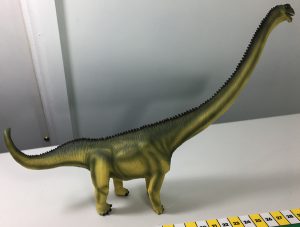Sauropods with their Heads Held High – the Debate Continues
New Report into the Posture of Sauropods
The sauropods, or to give them their correct taxonomic classification – Sauropoda, were long-necked, elephantine plant eaters, part of the Saurischia (lizard-hipped) group of Dinosauria. These animals are reputed to be the largest land animals of all time, with some of these creatures such as Brachiosaurus and the titanosaur, Paralititan reaching lengths in excess of 25 metres.
Sauropods
How these enormous creatures held their long necks has been the subject of much debate amongst palaeontologists. In the past, it was believed that these animals were able to hold their necks quite high, almost vertically in what has been described as the “swan neck” position, but now most scientists are dissuaded from this point of view. Indeed, this interpretation of sauropod fossil bones is very much out of favour, along with the view that these animals were so large that they had to live in water in order to have their great weight supported.
The More Traditional View of Sauropods
Picture credit: Everything Dinosaur.
Sauropod Dinosaur Models
Mojo Fun have created several sauropod dinosaur models including Mamenchisaurus, Brachiosaurus and Diplodocus.
To view this range of figures: Mojo Fun Prehistoric and Extinct Figures.
The view of these large creatures living in swamps and lakes, so that the water could help support their weight has been largely discredited, but the debate over how these animals used their necks continues. A new study has just been published in the scientific journal “Biology Letters” that examines the effect the position of a dinosaur’s head is in relation to its heart and the implications for blood pressure. Extant reptiles such as crocodiles and lizards have a very different anatomical structure to that of dinosaurs. Living reptiles standing in their natural posture have their heads virtually level with their hearts. They can raise their heads of course, but no living reptile possesses the immensely long neck or posture of a sauropod such as Brachiosaurus.
The hearts of modern reptiles are different in design from a human heart. They cannot separate pulmonary (blood to and from the lungs) and systemic blood (blood circulated around the rest of the body), they do not have a fully divided, chambered heart. Most dinosaurs from the smallest theropod such as Compsognathus to the large brachiosaurs, held their heads above their hearts. This implies that their hearts were fully divided ensuring that there would be enough blood pressure to pump blood to their elevated heads.
Sauropod Posture
This new study, led by Dr Roger Seymour, an evolutionary biologist from the University of Adelaide shows that a dinosaur’s head would have been so far above its heart that raising the head and neck would have caused the blood pressure to soar – to potentially fatal levels. This team argue that in the case of the sauropods, for example, these large herbivores would not have fed on the branches of tall trees, but grazed like cows keeping their heads and necks closer to the ground. The scientists found that the physical effort involved in lifting such long necks, some of which could measure over 15 metres long would have used up almost 50% of the energy derived from a sauropod’s diet just to circulate the blood.
Commenting on his study Dr Seymour stated:
“The long necks of gigantic sauropod dinosaurs are commonly assumed to have been used for high browsing to obtain enough food. However, this analysis questions whether such a posture was reasonable”.
The scientists estimated the energy required comparing the dinosaurs metabolic rate, blood flow and blood pressure.
Dr Seymour added:
“The analysis shows it would have required the animal to expend approximately half of its energy intake just to circulate the blood, primarily because a vertical neck would have required a high systemic arterial blood pressure”.
Intriguing New Study
The new study sounds intriguing but none of the team members at Everything Dinosaur have been able to read up on the details of this research. In their conclusions, the team have related the results to the potential lifestyles and habits of feeding sauropods. Rather than have them browsing on the tops of trees, they comment that the majority would have fed lower to the ground.
“It is therefore energetically more feasible to have used a more or less horizontal neck to enable wide browsing while keeping blood pressure low”.
This sounds a fascinating article one that contributes to the debate over the structure of dinosaur hearts and the resulting implications for metabolic rate and endothermic applications. Sir Richard Owen commented on the fact that dinosaurs may have led “more energetic lives” than extant reptiles in 1841. He concluded that they must have had a fully divided heart like mammals and birds and alluded to the possibility that the dinosaurs may have been warm blooded.
Sir Richard Owen stated:
“from their superior adaptation to terrestrial life, to have enjoyed the function of such a highly organised centre of circulation [the heart] in a degree more nearly approaching that which now characterises the warm-blooded Vertebrata [mammals and birds]“.


